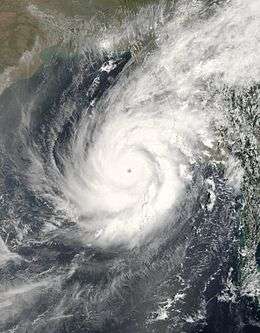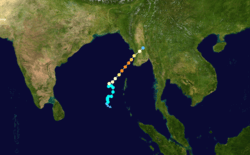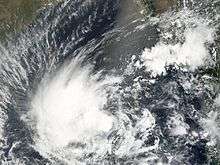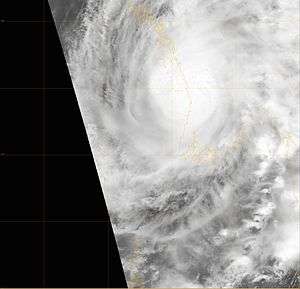Cyclone Mala
Cyclone Mala was the strongest tropical cyclone of the 2006 North Indian Ocean cyclone season.[1] In mid-April 2006, an area of disturbed weather formed over the southern Bay of Bengal and nearby Andaman Sea. Over a period of several days, the system became increasingly organized and was classified as a depression on April 24. Situated within a region of weak steering currents, the storm slowly intensified as it drifted in a general northward direction. It attained gale-force winds and was named Mala the next day. Conditions for strengthening improved markedly on April 27 and Mala subsequently underwent rapid intensification which culminated in the cyclone attaining its peak. Early on April 28, the cyclone had estimated winds of 185 km/h (115 mph). The Joint Typhoon Warning Center considered Mala to have been slightly stronger, classifying it as a Category 4-equivalent cyclone. Steady weakening ensued thereafter and the storm made landfall in Myanmar's Rakhine State on April 29. Rapid dissipation took place once onshore and Mala was last noted early the next morning.
| Extremely severe cyclonic storm (IMD scale) | |
|---|---|
| Category 4 tropical cyclone (SSHWS) | |
 Cyclone Mala on April 28, near peak intensity | |
| Formed | April 24, 2006 |
| Dissipated | April 30, 2006 |
| Highest winds | 3-minute sustained: 185 km/h (115 mph) 1-minute sustained: 220 km/h (140 mph) |
| Lowest pressure | 954 hPa (mbar); 28.17 inHg |
| Fatalities | 37 total |
| Damage | $6.7 million (2006 USD) |
| Areas affected | Andaman Islands, Myanmar, Northern Thailand |
| Part of the 2006 North Indian Ocean cyclone season | |
In contrast to Mala's intensity, damage was relatively minimal across Myanmar due to adequate early warnings, while timely and effective evacuations minimized loss of life along the coast. The greatest damage resulted from a thunderstorm near Yangon on April 28 that spawned a possible tornado in an industrial zone. A total of 586 homes were damaged there. Just outside the city in the Hinthada District, a flash flood killed at least 18 people. Overall, the storm claimed 37 lives in the country and left US$6.7 million in damage. In the wake of Mala, the Red Cross distributed relief aid to affected residents while local officials set up shelters to house those left homeless. Government and social organizations donated 5.4 million kyat (US$4,320) in cash to survivors in the Ayeyarwady Region.
Meteorological history

In mid to late April 2006, a pulse in the Madden–Julian oscillation, coupled with a Kelvin wave (which later contributed to the formation of Typhoon Chanchu in the western Pacific), enhanced convective activity over the Bay of Bengal.[2] By April 22, a trough developed along an axis from the southern Bay of Bengal eastward to the Andaman Sea.[1] The Joint Typhoon Warning Center (JTWC) began monitoring the system for potential tropical cyclogenesis the following day.[3] By 0600 UTC on April 24, an area of low pressure formed southeast of the Andaman Islands and the India Meteorological Department (IMD) began monitoring the disturbance.[4] Quickly organizing, the low developed into a tropical depression later on April 24 and the JTWC began writing full advisories on the cyclone without issuing a Tropical Cyclone Formation Alert.[3][5] Organization slowed thereafter due to moderate wind shear,[6] but continued at a near-climatological rate as upper-level outflow allowed for continued convective development.[7] Early on April 25, the JTWC estimated the system to have attained gale-force winds.[5] The IMD followed suit later that day and subsequently assigned it the name Mala.[8][nb 1] Weak steering currents prompted slow and erratic movement with an overall northward trajectory.[3][6]

Forecasters at this time anticipated little intensification as the system was expected to move into a region of higher shear.[10] However, on April 27, the system moved under a subtropical ridge and conditions quickly became favorable for intensification. The presence of the ridge greatly enhanced the outflow over the cyclone and an eye developed by 1200 UTC.[1][11] By this time, both the JTWC and IMD estimated Mala to have attained hurricane-force winds with the latter classifying it as a very severe cyclonic storm.[1][5] The previously weak steering currents became more established as well, with the storm now tracking northeast toward Myanmar through a weakness in a ridge over Southeast Asia.[11] Situated in an area with sea surface temperatures of 28 to 29 °C (82 to 84 °F), the cyclone was able to undergo rapid intensification as wind shear abruptly diminished.[1] The IMD estimated Mala to have reached its peak intensity at 0900 UTC on April 28 with winds of 185 km/h (115 mph) and a barometric pressure of 954 mbar (hPa; 28.17 inHg).[12] Using the Dvorak technique, a method of determining a tropical cyclone's strength via satellite imagery, the agency gave Mala a rating of T#5.5 which yields an intensity of 189 km/h (117 mph).[1]
The JTWC estimated Mala to have been a stronger system, with peak winds of 220 km/h (140 mph) and a pressure of 922 mb (hPa; 27.23 inHg) — equivalent to a Category 4 hurricane on the Saffir–Simpson hurricane wind scale.[5] Their Dvorak values peaked at T#6.5 or 235 km/h (146 mph).[13] As the powerful storm approached Myanmar, the combined effects of increasing wind shear and land interaction soon took their toll on Mala.[14] At 0700 UTC on April 29, Mala made landfall just south of Thandwe in Myanmar's Rakhine State as a very severe cyclonic storm.[1] The JTWC estimated winds at this time to have been 165 km/h (105 mph).[5] Rapid weakening ensued once the cyclone moved onshore. Within 12 hours of landfall, Mala weakened to a deep depression and was last noted as a dissipating system earl on April 30.[1]
Sea surface temperatures in the wake of Cyclone Mala decreased up to 4–5 °C (7–9 °F) due to upwelling.[15] From April 28–29, the low-level inflow associated affected much of the northern Bay of Bengal and resulted in northwesterly winds as far away as Hyderabad, India. These winds brought dry, dust filled air over the bay with mean particulate-matter doubling over the region.[16]
Preparations
On April 26, the local Department of Meteorology and Hydrology in Myanmar stated that the Ayeyarwady, Bago Region, and Yangon regions were likely to be affected within two days and Rakhine State within three days.[17] Officials began broadcasting storm warning to the public over radio the following day.[18] Evacuations of at-risk coastal areas were conducted, though specifics are unknown.[19] Once the storm moved inland, residents across the country were advised of the likelihood of widespread heavy rain from the remnant system.[20]
Despite never being forecast to strike Bangladesh, officials there warned residents that the storm could strike the nation and cause loss of life. Cautionary signals were raised at ports in Chittagong, Cox's Bazar, and Mongla, advising seafaring vessels to remain docked until the storm's passage.[21] Roughly 34,000 members of the Bangladesh Red Crescent Society were placed on standby for possible relief efforts.[9]
Flash flood warnings were issued across northern Thailand on April 29 under the threat of heavy rains from Mala's remnants.[18]
Impact

Throughout almost the entire existence of Mala, it produced rainfall in the Andaman and Nicobar islands. Daily totals peaked on April 27 at 100 mm (3.9 in) in Car Nicobar.[1]
After moving through Myanmar, Mala brought heavy rains to northern Thailand. According to local meteorologists the storm also accelerated the onset of the seasonal monsoon which would contribute to a wetter-than-average year for the region.[22]
Myanmar
Though Mala struck Myanmar as a powerful cyclone, early warnings and proper evacuations minimized loss of life along coastal areas. Additionally, no major storm surge was reported, limiting the potential for major damage. The most significant effects were caused inland from torrential rains rather than at the coast.[19] Overall, the storm claimed 37 lives and left 1.24 billion kyat (US$6.7 million) in damage.[23][24][25] Approximately 12,000 families were significantly affected by the cyclone.[26]
Rakhine State suffered a direct hit from the cyclone, with Gwa Township reporting the worst damage. There, 88 homes were destroyed and 1,246 more were damaged. One person was killed and at least four others were injured in the township. Ra Haing Ku Toe village suffered significant losses as well, with 132 homes destroyed and 531 more damaged.[27] A storm surge of 4.57 m (15.0 ft) struck the region, but did not impact populated areas.[24]
Across the Irrawaddy Delta, hurricane-force winds caused extensive damage to housing and infrastructure.[27] Haigyi Island was the first area struck by the storm. Several homes were destroyed and many more lost their roof there.[28] Thunderstorms from the storm's outer bands on April 28 damaged 586 homes in Hlaingthaya Township. Residents described what appeared to be a tornado as the cause of the damage. The Hlaingthaya industrial zone was hardest hit, with five factories destroyed and dozens of homes having their roof torn off.[29] Locals, however, claimed that the damage was more severe than reported by the government.[30] Cars were reportedly tossed into the air during the storm.[29] Two people were killed and fourteen others were injured in Hlaingthaya.[27] The winds also downed numerous power lines, leaving many without electricity.[30] In Labutta Township, near the southern tip of the Delta, 88 homes were destroyed.[27] In the Hinthada District, torrential rains caused flash flooding that killed 18 people and left 14 others missing.[19]
Aftermath
By May 1, the local branch of the Red Cross distributed essential supplies to residents in Labutta Township. In coordination with the Disaster Assistance Response Team, the areas in greatest need for aid were identified and requests for tarpaulin were made.[27] Members of the Cabinet of Burma donated 3.7 million kyat (US$2,960) in cash and 140 bags of rice to victims in the Ayeyarwady Region.[31] On May 3, another 1.7 million kyat (US$1,360) was donated by social organizations to residents in rural areas outside Yangon.[32] Temporary shelters were set up across Gwa Township. Local donations provided residents in the town with 200,000 kyat (US$160) worth of blankets, clothes, and cash.[27] A local newspaper, The New Light of Myanmar, claimed that government officials immediately provided assistance to affected residents across the country.[33] Red Cross operations continued through November 30, by which time 3,485 families were provided with aid.[26] Additionally, though the agency planned to assist 4,000 families with rebuilding their homes, a lack of necessary funds prevented the operation. Instead, a cash donation was provided to the 1,000 most affected families.[34]
See also
- 2006 North Indian Ocean cyclone season
- Cyclone Nargis – A storm of similar intensity two years later that devastated the Irrawaddy Delta
- Cyclone Giri – A storm of similar intensity in 2010 that caused significant damage in areas just north of where Mala struck
- Cyclone Maarutha – A storm of weaker intensity in 2017 that caused some notable damage in northwestern areas of Myanmar in April
Notes
- The name Mala is Sinhalese as well as Hindi for a garland of flowers.[9]
References
- A. B. Mazumdar; R. R. Lele; S. Sunitha Devi (July 2007). "Cyclones and depressions over the north Indian Ocean during 2006" (PDF). मौसम Mausam. India Meteorological Department. 58 (3): 305–322. Archived from the original (PDF) on September 24, 2015. Retrieved May 7, 2014.
- Wallace Hogsett; Da-Lin Zhang (December 2010). "Genesis of Typhoon Chanchu (2006) from a Westerly Wind Burst Associated with the MJO. Part I: Evolution of a Vertically Tilted Precursor Vortex". Journal of the Atmospheric Sciences. 67 (12): 3774–3792. Bibcode:2010JAtS...67.3774H. doi:10.1175/2010jas3446.1.
- O'Hara, J. F.; Falvey, Robert (2007). "Tropical Cyclone (TC) 02B (Mala)" (PDF). In Lana, Aaron (ed.). 2006 Annual Tropical Cyclone Report. Pearl Harbor: U.S. Naval Maritime Forecast Center / Joint Typhoon Warning Center. p. 44. Retrieved May 7, 2014.
- "Tropical Weather Outlook". India Meteorological Department. Unisys. April 24, 2006. Retrieved May 7, 2014.
- "Tropical Cyclone 02B (Mala) Best Track" (.TXT). Joint Typhoon Warning Center. United States Navy. 2007. Retrieved May 7, 2014.
- "Tropical Cyclone Advisories for April 25, 2006 at 1800 UTC". Joint Typhoon Warning Center. Unisys. April 25, 2006. Retrieved May 7, 2014.
- "Tropical Cyclone Advisories for April 25, 2006 at 0600 UTC". Joint Typhoon Warning Center; India Meteorological Department. Unisys. April 25, 2006. Retrieved May 7, 2014.
- Kenneth R. Knapp; Michael C. Kruk; David H. Levinson; Howard J. Diamond; Charles J. Neumann (2010). 2006 Mala (2006114N08090). The International Best Track Archive for Climate Stewardship (IBTrACS): Unifying tropical cyclone best track data (Report). Bulletin of the American Meteorological Society. Archived from the original on March 5, 2016. Retrieved May 7, 2014.
- "Bangladesh coast under cyclone warning". Associated Press. Dhaka, Bangladesh: USA Today. April 29, 2006. Retrieved May 8, 2014.
- "Tropical Cyclone Advisories for April 26, 2006 at 0600 UTC". Joint Typhoon Warning Center. Unisys. April 26, 2006. Retrieved May 7, 2014.
- "Tropical Cyclone Advisories for April 27, 2006 at 0600 UTC". Joint Typhoon Warning Center. Unisys. April 25, 2006. Retrieved May 7, 2014.
- "Some characteristic features of cyclonic disturbances formed over the Indian Ocean and adjoining region during 2006" (PDF). WMO/ESCAP Panel on Tropical Cyclones 34th Session. World Meteorological Organization. November 15, 2007. p. 33. Retrieved May 7, 2014.
- Gary Padgett (May 5, 2006). "Global Tropical Cyclone Tracks - April 2006". Australia Severe Weather. Retrieved May 7, 2014.
- "Tropical Cyclone Advisories for April 28, 2006 at 1800 UTC". Joint Typhoon Warning Center. Unisys. April 25, 2006. Retrieved May 7, 2014.
- K.V.S Badarinath; Shailesh Kumar Kharol; P.K. Dileep; V.K. Prasad (June 2009). "Satellite Observations on Cyclone-Induced Upper Ocean Cooling and Modulation of Surface Winds—A Study on Tropical Ocean Region". Geoscience and Remote Sensing Letters. 6 (3): 481–485. Bibcode:2009IGRSL...6..481B. doi:10.1109/LGRS.2009.2018487. ISSN 1545-598X.
- Shailesh Kumar Kharol; K. V. S. Badarinath; Anu Rani Sharma; V. Krishna Prasad; Dimitrios G. Kaskaoutis; Panagiotis T. Nastos; Harry D. Kambezidis (May 7, 2010). "Impact of tropical cyclones on aerosol properties over urban region of Hyderabad, India" (PDF). Geophysical Research Abstracts. NASA Astrophysics Data System. 12. Retrieved May 7, 2014.
- "Special Storm Warning". The New Light of Myanmar. Yangon, Myanmar. April 26, 2006.
- "Cyclone Mala reaches western Myanmar". Yangon, Myanmar. Agence France Presse. April 29, 2006 – via Lexis Nexis.
- Myanmar: Cyclone Mala Final Report for DREF Bulletin no. MDRMM01 (PDF). International Federation of Red Cross and Red Crescent Societies (Report). ReliefWeb. February 15, 2007. Retrieved May 6, 2014.
- "Storm Warning". The New Light of Myanmar. Yangon, Myanmar. April 29, 2006.
- "Cyclone spares Bangladesh, hits Burmese coast". The Daily Star. Dhaka, Bangladesh: British Broadcasting Company. May 1, 2006.
- Chiang Mai (May 3, 2006). "Early rains in North 'a sign of La Nina and wet year'". The Nation. – via Lexis Nexis (subscription required)
- "Myanmar: 2006 Progress Report" (PDF). International Federation of Red Cross And Red Crescent Societies. ReliefWeb. December 31, 2006. Retrieved May 8, 2014.
- Ministry of Social Welfare, Relief and Resettlement and the Ministry of Education (2008). "Natural Disasters in Myanmar" (PDF). Guidance on Mainstreaming Disaster Risk Reduction in the Education Sector, Myanmar - Rural Settings. Myanmar Information Management Unit. p. 16. Retrieved May 7, 2014.
- Tint Zaw; Mu Mu Than (March 2010). "Climate Change Impacts to the Water Environment and Adaptation Options" (PDF). Union of Myanmar Ministry of Agriculture and Irrigation. Water Environment Partnership in Asia. p. 9. Retrieved May 7, 2014.
- "Myanmar: Cyclone Mala DREF Bulletin MDRMM001 Update No. 2". International Federation of Red Cross And Red Crescent Societies. ReliefWeb. November 6, 2006. Retrieved May 8, 2014.
- "Myanmar: Cyclone Mala Information Bulletin No. 1". International Federation of Red Cross And Red Crescent Societies. ReliefWeb. May 3, 2006. Retrieved May 6, 2014.
- "Myanmar authorities put on alert after cyclone destroys homes in southwestern delta region". Yangon, Myanmar. Associated Press International. April 28, 2006 – via Lexis Nexis.
- "Cyclone Mala kills two in Burma". The Nation. Yangon, Myanmar. Associated Press. May 1, 2006. p. 4A. Retrieved May 6, 2014.
- "Cyclone Mala kills one and injures 21 in Myanmar". Yangon, Myanmar. Agence France Presse. April 30, 2006 – via Lexis Nexis.
- "Myanmar: Commander, Minister donate relief supplies to cyclone victims in Ayeyawady Division". Government of Myanmar. ReliefWeb. May 1, 2006. Retrieved May 6, 2014.
- "Myanmar: Relief provided to cyclone victims". Government of Myanmar. ReliefWeb. May 3, 2006. Retrieved May 6, 2014.
- "Cyclone Mala leaves 18 drowned, 14 missing in Kyangin". The New Light of Myanmar. Nay Pyi Taw, Myanmar. May 3, 2006.
- "Myanmar: Cyclone Mala DREF Bulletin MDRMM001 Final Report" (PDF). International Federation of Red Cross And Red Crescent Societies. ReliefWeb. February 15, 2007. Retrieved May 8, 2014.
